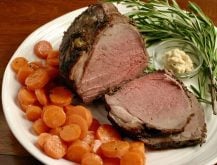When something good happens in a small town, the community shares in this joy. One joy that our town is celebrating is the arrival of a new baby girl. We only get one or two new babies a year, so it is a big event.
Another joy for this summer is the opening of an ice cream parlour on Main Street. It is a wonderful meeting place. During evenings while out for a walk or a bike ride, many people stop for ice cream. While there, they visit with other town folk who are doing the same.
Read Also

Rural Manitoba resources slim on natural disaster planning
A study from Brandon University’s Rural Development Institute has found that many rural and small municipalities don’t have the staff or resources to make formal climate plans against natural disaster.
Saskatoon berry vinaigrette
Chefs Peter Phillips and Michael Beaule developed this recipe for a contest sponsored by Canola Info.
3/4 cup red wine vinegar 175 mL
3/4 cup saskatoon berries 175 mL
2 tablespoons borage honey 30 mL
1 cup canola oil 250 mL
1 teaspoon fresh thyme, 5 mL
chopped
1/4 teaspoon salt 1 mL
1/4 teaspoon black pepper 1 mL
ground
Place berries, vinegar and honey in a saucepan. Bring to a boil and then simmer for four minutes to soften berries. Puree with canola oil, thyme, salt and pepper. Do not crush all berries, leave some whole for texture. Cool and enjoy.
- Blueberries can be substituted for saskatoon berries.
- For a lighter vinaigrette, reduce canola oil to 3/4 cup (175 mL).
- In this recipe the chefs preferred borage honey, but other honey can be substituted.
Cooking kale
Dear TEAM: We are told to eat leafy green vegetables for good health. Could you give me pointers on cooking and serving kale? So far I just steam the younger leaves. The taste is not exciting. It grows easily and well in the garden and I would like to use it. – P.P., Bowsman, Man.
Dear P.P.: I hadn’t cooked with kale until receiving your letter. It is fun to try new foods and so I thank you for asking about kale.
With the interest in healthy eating, kale is enjoying a new popularity. It is low in calories and virtually fat free, a good source of calcium and vitamins A and C. Also, present in smaller amounts are vitamin E and the minerals iron, zinc, magnesium and folate as well as important dietary fibre. Kale is a non-heading form of the cabbage family, easily identified by its frilly leaves, arranged in a loose bouquet. The most common variety is deep green in colour, but others are yellow-green, red or purple. The coloured varieties or “flowering” kale – sometimes called salad savoy – are most often grown for ornamental purposes. They are edible but have a stronger flavor than regular kale.
The longer kale is stored in the fridge, the more its mild and cabbagey flavour turns piquant and bitter. Use within a day or two of purchase or picking and wash it thoroughly. Then cook it as quickly as possible. The spinach substitute can be steamed, blanched, braised, microwaved or sautéed.
Braising is a great way to give kale a richer flavour.
- Remove tough stems. In large saucepan, bring about a half inch (one cm) of water to boil; add one bunch of kale. Return to boil; simmer, covered for about four minutes or until limp.
- Drain well and chop coarsely.
- In same saucepan, heat two tablespoons (30 mL) cooking oil over medium heat. Add one crushed clove of garlic and cook about one minute or until softened.
- Add kale, cook, stirring, for one minute until heated through. Chicken or vegetable broth can be added to the pan. Cook until the broth evaporates.
- Season to taste with salt and pepper. Serve immediately.
Sautéing: Kale can be sautéed after being blanched or without blanching. If it is blanched first, all it takes is a little oil, two to three tablespoons (30-45 mL) for a large bunch, and a quick heating in a large saucepan. For smaller amounts, cut back on the oil accordingly.
If you’d rather sauté without any added fat, broth is a good substitute. In a non-stick saucepan, put enough chicken or vegetable stock to generously cover the bottom. For extra seasoning, add finely chopped garlic, onions, leeks or shallots. Bring to a boil and toss in prepared kale. Lower temperature to medium-high and simmer until kale is limp and wilted but not mushy, for three to 15 minutes. You may need to add more stock to the pan as it evaporates.
Sausage with kale and potatoes
2 cups kale 500 mL
sliced or coarsely chopped
3/4 lb. kielbasa or 375 g
other smoked sausage
1 large onion, chopped
1 clove garlic, minced
2 large baking potatoes, peeled and
sliced into 1/4 inch (0.5 cm) slices 2 cups chicken broth 500 mL
homemade or canned
1 tablespoon balsamic 15 mL
or white vinegar
1 teaspoon salt, optional 5 mL
1/2 teaspoon pepper 2 mL
1 can (141/2 oz.) tomatoes 398 mL
whole with liquid
Rinse kale in several changes of water; remove and discard stems. Slice or coarsely chop leaves.
Place sausage in unheated dutch oven. Over low heat, cook until meat begins to render fat, about two minutes. Increase heat to medium; cook until meat is lightly browned around edges. Remove sausage from pot. Pour off all but one tablespoon (15 mL) of drippings.
Add onion, garlic and potatoes to pot. Cook and stir gently until onion is transparent.
Stir in kale; cover and cook about two minutes. Return sausage to pot. Stir in broth, vinegar, salt and pepper. Bring to boil; reduce heat. Cover and simmer gently one hour, stirring in tomatoes during last 30 minutes.
From: Low-Fat Soul by Jonell Nash, Ballantine Books, 1996.
Alma Copeland is a home economist from Elrose, Sask., and one of four columnists comprising Team Resources. Send correspondence in care of this newspaper, Box 2500, Saskatoon, Sask., S7K 2C4 or contact them at team@producer.com.














